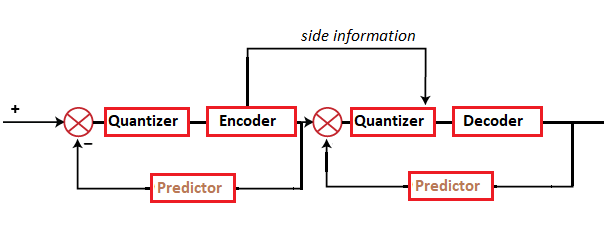Adaptive Differential Pulse Code Modulation (ADPCM)ADPCM is a type of DPCM (Differential Pulse Code Modulation). It is also a differential coding technique that uses differential values like DPCM. ADPCM was developed to overcome the drawbacks of the DPCM (Differential Pulse Code Modulation) and DM (Delta Modulation). However, a method of DM named Continuous Variable Slope Delta Modulation (CVSDM) has more advantages than ADPCM. Unlike DPCM, the signal variation in ADPCM helps to change the step size of the quantization levels. It reduces the overload error during the modulation process. The step size is directly proportional to the speed rate of the input message. If the variation of the message signal is at a high rate, the step size will be high. Similarly, if the variation of the message signal is at a slower rate, the step size will be small. DPCM requires fewer levels for the quantization process as compared to the PCM (Pulse Code Modulation) process. ADPCM requires fewer numbers of levels as compared to both the DPCM and PCM. It means that ADPCM provides better bandwidth reduction than DPCM and PCM. The numbers of levels are directly proportional to the bandwidth. The fewer the levels, the lesser the bandwidth will be. Block DiagramThe block diagram of the Adaptive differential PCM is shown below: 
The block diagram of ADPCM contains the quantizer at ends, encoder, predictor (as the feedback loop), and a decoder. The function of the encoder is similar to the modulation process, and the function of the decoder is similar to the demodulation. Various channels of 16k bits, 24, 32, and 40k bits have different applications. For example, 16k and 24k bits channel is used to carry voice with DCME (Digital Circuit Equipment). QuantizerA quantizer is present in the circuit of ADPCM at both the transmitting and receiving ends of the circuit. It reduces the number of discrete symbols. It adds some redundant bits and compresses the data to make it suitable for storage and transmission. EncoderAn encoder is a device that converts the analog signal to digital pulses. It responds to each sample by generating a binary pulse or pattern. It also reduces the transmission bandwidth depending on the step size of between the quantization levels. Different levels quantizer can be used for assigning different number of binary digits. QuantizerIt works as a reverse quantizer. It generates a quantized opposite signal using these same binary digits. Adaptive predictorIt completes the feedback loop by generating the estimation of the input signal. The feedback loop detects the variations in the message signal, which helps in changing the step size. DecoderThe digitally encoded signal arrives at the receiver. It first removes the noise from the signal. The quantization process does not allow the easy separation of the signal and the noise. Hence, it is essential to remove the noise from the signal at the decoding stage. It works similar to the demodulation process and converts the binary pulses to the original form or the analog signal. Advantages of ADPCMThe advantages of ADPCM are as follows:
Disadvantages of ADPCMThe disadvantages of ADPCM are as follows:
Applications of ADPCMADPCM is used in various applications, such as IP telephony, also known as VoIP (Voice over Internet Protocol). It is a technology that delivers voice transmissions over the IP (Internet Protocol). The ADPCM algorithm is used to increase the line's capacity to twice. This process is named G.726, a speech-coded standard covering the voice transmission at different rates (16k bits, 24, 32, and 40k bits). ADPCM vs. DPCMLet's discuss the differences between these two types of PCM. The differences between ADPCM and DPCM are listed below:
Next TopicSampling
|
 For Videos Join Our Youtube Channel: Join Now
For Videos Join Our Youtube Channel: Join Now
Feedback
- Send your Feedback to [email protected]
Help Others, Please Share










